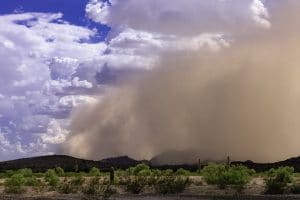The Dangers of Sandstorms for Arizona Drivers
 Last month, a sandstorm in Utah was the catalyst for a series of car crashes that claimed the lives of eight people and injured ten; four of the victims were adults, and the remaining four were children. The high winds began to kick up sand and dust around 4:30 pm on July 25. The lack of visibility that was caused by the sandstorm led to a 22-vehicle pileup on Interstate 15 near Filmore.
Last month, a sandstorm in Utah was the catalyst for a series of car crashes that claimed the lives of eight people and injured ten; four of the victims were adults, and the remaining four were children. The high winds began to kick up sand and dust around 4:30 pm on July 25. The lack of visibility that was caused by the sandstorm led to a 22-vehicle pileup on Interstate 15 near Filmore.
When the Utah Highway Patrol arrived on the scene, vehicles were located and discovered in all types of positions on the roadway; several vehicles were located off of the roadway, while some vehicles ended up flipped on their sides. The eight victims were traveling in three different cars. Five of the eight victims were traveling in the same vehicle, two of the victims were traveling in a second car, and the final victim was traveling in a third car.
Sadly, sandstorms are not a phenomenon that occurs only in Utah. Anyone who lives in Arizona alone is familiar with the frequency of sandstorms – and given the increasing levels of drought here in the West, there’s a good chance we’ll see even more of them. These storms present dangerous conditions for drivers and put many peoples’ lives at risk. The worst time to become aware of what to do during a sandstorm is when you’re in the middle of one.
What are sandstorms?
Sandstorms are created when inorganic and organic debris moves from the land’s surface. A sandstorm is created when strong winds cause the air in a certain area to become overwhelmed with loose sand that is dry. Sandstorms can be created with wind speeds of 25 MPH or less, which means that they do not have to be at hurricane force to create a sandstorm. Sandstorms happen most often at 10 feet off the ground but can occur as much as 50 feet off the ground if the conditions are extreme.
What is the difference between a sandstorm and a dust storm?
While sand and dust storms are similar in formation, the duration of both conditions depends on two factors: the weather conditions and the size of the particles. Because dust particles range in size from two to ten microns, the particles can be carried by winds hundreds to thousands of miles and can elevate to 10,000 feet above the ground. As a result, dust can remain in the air from either a few hours to a few days.
Sand particles, on the other hand, are heavier than dust particles, with a weight of 60 microns or greater. Because of the excess weight, the sand will not reach as high in the air, nor will it remain in the atmosphere as long as the dust particles.
Why is it dangerous to drive during a sandstorm?
Driving while in a sandstorm is dangerous for two primary reasons: they make it impossible to see, and sand wreaks havoc on engines.
Sandstorms cause a mass reduction in visibility
Because sandstorms have the ability to form quickly and without warning, visibility on the road can be diminished in an instant. It’s what led to the fatal accident we discussed earlier: the combination of high winds and sand particles reduce visibility to zero, making it impossible to travel safely on the roads. With the atmosphere turning pitch black due to a sandstorm, it would be the equivalent of driving while blind.
Breakdowns in machinery
Sand particles can find their way into various parts of machinery and cause breakdowns. They can clog the air filter, leading to a breakdown. They can get into the brake pads and the vehicle’s sensors, making it unsafe. It can even affect your seat belts, if it gets into the car via the vents from your air conditioning.
In addition to causing breakdowns, sand can ruin your windshield (think about what sandpaper would do to glass) and destroy the vehicle’s paint.
What health issues are caused by sandstorms?
People who are caught in a sandstorm can experience several respiratory issues, according to the American Thoracic Society. If a person inhales any sand particles, those sand particles will be stuck in the upper airway and cause irritation to the person’s eyes, nose, and airways. Severe coughing, wheezing, and other breathing-related issues are more likely to occur during a sandstorm. For individuals who suffer from respiratory conditions such as asthma, there is a greater risk of experiencing attacks due to the atmosphere of the sandstorm.
What should I do if I get stuck in a sandstorm?
When in the midst of a sandstorm, remember this quintessential phrase: Pull Aside, Stay Alive. The most important objective for any driver traveling through a sandstorm is to immediately pull off of the road in the safest way possible. You want to immediately check around your vehicle for all traffic around you and begin slowing down. You do not have to wait until the visibility is at its poorest to begin to exit the roadway; as soon as possible and when it’s safest to do so, you can begin to exit.
When searching for a safe space to pull over, do not do so in a lane of travel or an emergency lane. Once your vehicle is parked, make sure to turn off all of the lights. It is common for drivers to mistakenly use the lights of other vehicles as a guide and collide with parked vehicles as a result. After your vehicle is parked, all there is left to do is to set the emergency brake, remove your foot from the brake, keep your seatbelt on and wait for the storm to pass.
At Plattner Verderame, we represent victims of car accidents caused by sandstorms. These dangerous and deadly incidents can be exacerbated by inattentive, impaired, or drowsy drivers. Call our office at 602-266-2002 or complete a contact form on our website to schedule a consultation with a Phoenix or Tempe personal injury attorney today.

Attorney Richard Plattner has been active in leadership in the Arizona Association for Justice (lawyers who represent injured folks, and formerly known as the Arizona Trial Lawyers Association) since 1985 and served as President in 1991. If you have been the victim of a personal injury, contact Plattner Verderame today.
Read more about Richard Plattner.
